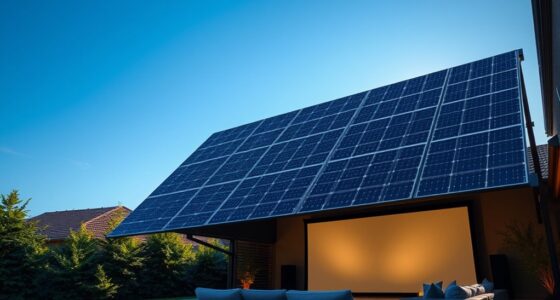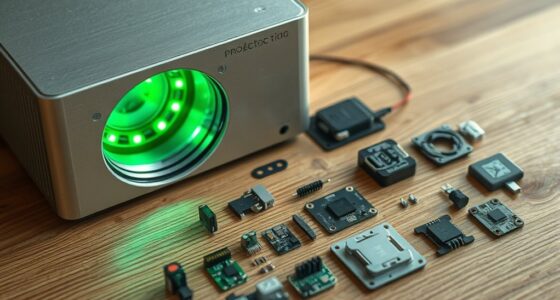To reduce standby power consumption, unplug devices when not in use or use power strips with switches to cut power easily. Enable energy-saving modes on electronics and consider smart plugs or automation systems for remote control. Organize your home to turn off infrequently used gadgets, saving energy and money. Small changes like these help minimize phantom loads and lower your environmental impact. Keep exploring to discover more simple ways to cut back on unnecessary energy use.
Key Takeaways
- Unplug devices when not in use or use power strips with switches to cut off phantom loads.
- Enable energy-saving or automatic standby modes on electronics to reduce power draw.
- Invest in smart plugs or home automation systems for remote control and scheduling of device power.
- Choose energy-efficient appliances with ENERGY STAR ratings to minimize standby power consumption.
- Develop habits of turning off or unplugging seldom-used electronics to lower overall energy waste.

Have you ever wondered how much energy your devices squander when they’re turned off or on standby? It might surprise you to learn that many household electronics, from TVs to chargers, continue to draw power even when they’re not actively in use. This phenomenon, known as standby power consumption, can silently add up over time, increasing your energy bills and contributing to unnecessary environmental impact. Luckily, there are practical steps you can take to cut down on this waste, starting with choosing energy efficient devices. When shopping for new appliances, look for products labeled with energy efficiency ratings or certifications like ENERGY STAR. These devices are designed to minimize power draw in standby mode, helping you save money and reduce your carbon footprint. But it’s not just about buying smarter; implementing effective power management strategies is equally important.
One of the simplest and most effective strategies is unplugging devices when you don’t need them. Chargers, for example, often continue to draw power even after your device is fully charged or when they’re not connected. Using power strips with on/off switches allows you to turn off multiple devices at once, preventing phantom loads from draining energy. Setting your electronics to power down automatically after periods of inactivity can also help. Many modern devices have built-in settings that enable automatic standby or energy-saving modes—taking advantage of these features ensures your devices aren’t wasting power unnecessarily. Moreover, organizing your home so that seldom-used electronics are powered down or unplugged can dramatically reduce standby consumption. For example, only keeping essential devices plugged in and turning off or disconnecting the rest can make a noticeable difference over months and years.
Another smart move involves investing in smart plugs or home automation systems. These tools give you remote control over your appliances, allowing you to turn off devices when they’re not in use, even if you’re away. They also enable scheduling, so devices only draw power during designated times. Combining these devices with energy efficient appliances maximizes savings while maintaining convenience. Additionally, understanding mindfulness in your energy habits can help you develop a more conscious approach to managing power consumption and reduce waste. Remember, small adjustments add up. By consciously managing your device usage and opting for energy efficient options, you can considerably reduce standby power consumption. Not only will you see a decline in your energy bills, but you’ll also play a part in reducing overall energy demand. Overall, making informed choices about the devices you buy and adopting power management strategies is key to minimizing waste and fostering a more sustainable lifestyle.
Frequently Asked Questions
How Can I Identify Which Devices Waste the Most Standby Power?
You can identify which devices waste the most standby power by using energy monitoring tools, which track their energy use in real-time. Check device energy labels for power consumption details, especially for electronics like TVs, chargers, and gaming consoles. Unplug devices not in use or use smart power strips to cut standby power. Regular monitoring helps you see which devices consume the most and take action to save energy.
Are There Specific Appliances That Should Always Be Unplugged?
Think of your appliances as a busy orchestra—some keep playing quietly in the background, wasting energy. You should always unplug devices like chargers, gaming consoles, and older electronics that aren’t energy efficient. Use energy-efficient outlets with timers for essential items. Appliance pruning helps you identify and turn off or unplug unnecessary appliances, reducing standby power waste and saving money. Keep this routine, and you’ll conduct a more harmonious and energy-savvy home.
Does Using a Power Strip Eliminate Standby Power Consumption?
Using a power strip benefits you by making standby power reduction easier. When you turn off the strip, it cuts power to all connected devices, eliminating standby energy use. This way, you don’t have to unplug each device individually, saving you time and effort. Just remember to switch off the strip when appliances aren’t in use, and you’ll effectively reduce unnecessary standby power consumption.
How Do Smart Home Devices Influence Overall Standby Power?
Imagine a symphony where each instrument’s harmony boosts the whole—smart home devices do this for your energy use. They influence overall standby power by enabling energy-efficient gadgets and smart device management, reducing unnecessary power drain. With these devices, you can control and schedule power, cutting standby energy loss. This way, you turn your home into a well-orchestrated space, conserving energy while enjoying modern convenience.
What Are the Long-Term Cost Savings of Reducing Standby Power?
By reducing standby power, you’ll see long-term cost savings through lower energy bills as your devices consume less power when not in use. This also benefits the environment by decreasing overall energy demand, which reduces greenhouse gas emissions. Over time, these energy savings add up, making your household more efficient and eco-friendly. Plus, you’ll contribute to a healthier planet while saving money on utility costs.
Conclusion
Reducing standby power can markedly cut your energy bills and environmental impact. Did you know that standby power accounts for about 10% of household energy use? By unplugging devices or using power strips, you can easily save money and reduce waste. Every small effort counts, and making these simple changes can add up over time. Take action today—your wallet and the planet will thank you for it.














